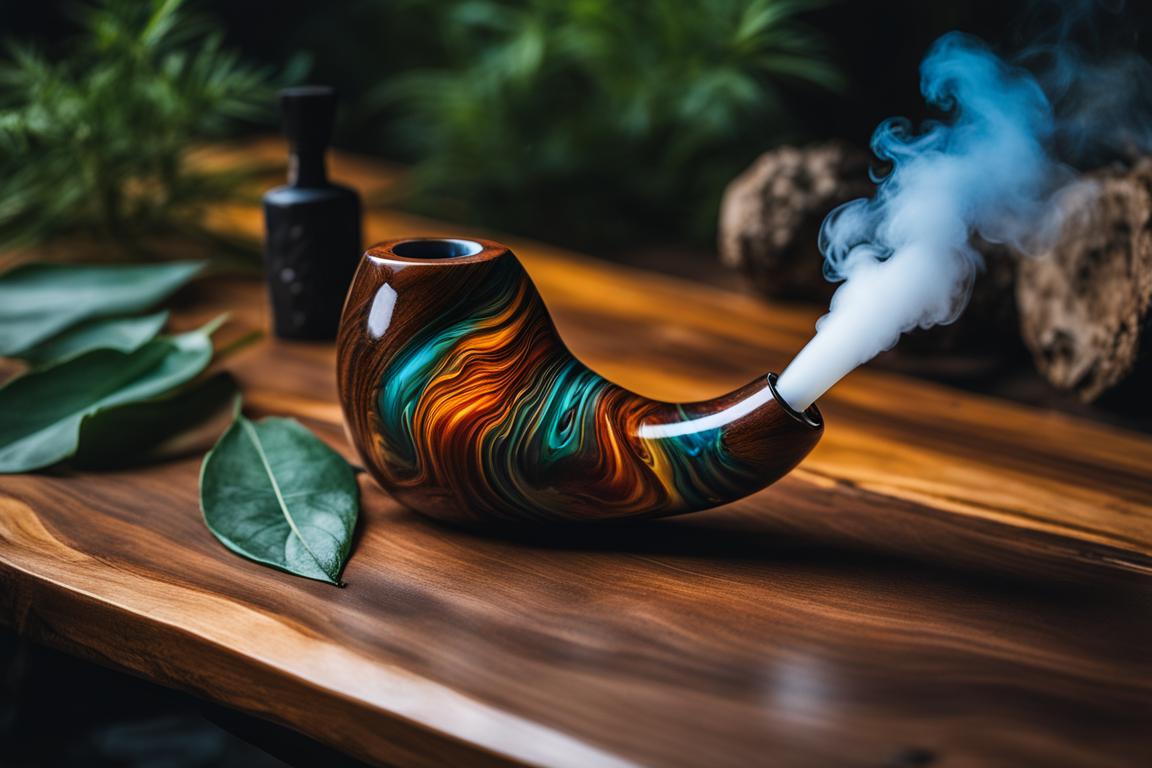Vaping has gained widespread popularity as a modern alternative to traditional smoking. However, what if you find yourself without a vape device? Can you smoke vape juice in a pipe instead? In this article, we will explore this question and provide you with alternative methods for enjoying vape juice without a vape.
While smoking vape juice in a pipe may seem like a viable option, it is important to understand the potential risks and drawbacks associated with it. Vape juice, also known as e-liquid, is specifically formulated for use with electronic cigarettes and vaporizers. It is not intended to be used in traditional smoking methods such as pipes or cigarettes.
Smoking vape juice in a pipe can result in the combustion of the liquid, leading to the release of harmful byproducts. This can diminish the flavor and experience of vaping and may even pose health risks. Additionally, the viscosity of vape juice may not be suitable for smoking in a pipe, as it is designed to be heated and vaporized, rather than burned.
Instead of smoking vape juice in a pipe, there are alternative methods you can try if you don’t have access to a vape device. These methods are specifically designed to provide a safer and more enjoyable vaping experience without the need for a traditional vape. Let’s explore some of these techniques in the following sections.
Table of Contents
Toggle- Tools Needed to Smoke Vape Juice Without a Vape
- How to Smoke Vape Juice Without a Vape: Three Step-by-Step Guides
- The Dangers of Secondhand Vaping
- Who is at Risk of Secondhand Vaping?
- The Importance of Understanding the Dangers of Vaping
- Conclusion
- FAQ
- Can you smoke vape juice in a pipe?
- How can you smoke vape juice without a vape?
- What tools are needed to smoke vape juice without a vape?
- What are the dangers of secondhand vaping?
- Who is at risk of secondhand vaping?
- Why is it important to understand the dangers of vaping?
- Can vaping in general be harmful?
- What are safer alternatives to vaping or smoking vape juice in a pipe?
- Related posts:
Key Takeaways:
- Smoking vape juice in a pipe is not recommended due to potential health risks and diminished flavor.
- Vape juice is specifically formulated for use with electronic cigarettes and vaporizers.
- Alternative methods can provide a safer and more enjoyable vaping experience without a traditional vape.
- Exploring these alternative methods can help you continue enjoying vape juice without compromising your health.
- It is important to prioritize your well-being and choose safer alternatives to smoking or vaping.
Tools Needed to Smoke Vape Juice Without a Vape
If you’re curious about trying alternative methods to smoke vape juice without a vape, you’ll need a few essential tools. By utilizing these tools, you can enjoy the flavors and sensations of vaping without the need for a traditional vape device. So, what do you need? Let’s take a look:
- Light bulb vaporizer
- Vape juice or vape juice ingredients
- Scissors
- Straw
- Two hot knives
- Stove or lighter
- Dab rig
- Nail
- Blowtorch
These tools will be the building blocks of your alternative smoking methods. With them, you can create makeshift vaporizers and heating devices to enjoy your favorite vape juices. But how exactly do you use these tools? Let’s explore the step-by-step guides in the next section to learn more.
Exploring Alternative Methods:
“When the traditional vape device isn’t available, you can still get creative and satisfy your cravings.”
How to Smoke Vape Juice Without a Vape: Three Step-by-Step Guides
If you find yourself without a vape but still want to experience the flavors of vape juice, don’t worry! There are alternative methods for smoking vape juice without a vape. In this section, we will explore three step-by-step guides that will help you enjoy vape juice without the need for a vape device.
Method 1: Light Bulb Vaporizer
One way to smoke vape juice without a vape is by creating a homemade light bulb vaporizer. Here’s how:
- Start by removing the metal component of the light bulb.
- Carefully break the ceramic part of the bulb, making sure to remove any loose pieces.
- Take out the filament from the bulb.
- Clean the bulb thoroughly to remove any residual debris.
- Fit a plastic cap or a small bottle cap onto the opening of the bulb.
- Securely tape up the cap to ensure airtightness.
- Finally, fill the bulb with your desired vape juice.

Method 2: Hot Knife Method
The hot knife method is another popular way to smoke vape juice without a vape. Follow these steps:
- Take two kitchen knives and heat them using a stove or a lighter until they become hot.
- Once the knives are hot, place a small amount of vape juice on the tip of one of the knives.
- Quickly press the other knife against the vape juice, vaporizing it and creating an inhalable vapor.
- Be cautious to avoid burning yourself during the process.
Method 3: Dabbing Method
The dabbing method allows you to smoke vape juice using a dab rig, a nail, and a blowtorch. Here’s how:
- Heat the nail of your dab rig using a blowtorch until it reaches the desired temperature. Make sure to follow the manufacturer’s guidelines for heating.
- Apply a small amount of vape juice to the heated nail, which will vaporize the liquid.
- Inhale the vapor through the dab rig’s mouthpiece to enjoy the flavors of the vape juice.
These three step-by-step guides provide alternative ways to smoke vape juice without a vape device. However, it’s important to note that these methods may not be as safe or efficient as using a proper vape device. Use caution and ensure proper ventilation when experimenting with these alternative smoking methods.
The Dangers of Secondhand Vaping
Secondhand vaping poses significant health risks, comparable to those associated with secondhand smoking. When individuals inhale the aerosol emitted by e-cigarettes, it can lead to various adverse effects on their respiratory system and overall well-being.
The inhalation of e-cigarette aerosol can cause irritation of the airways, leading to symptoms such as coughing, wheezing, and shortness of breath. Prolonged exposure to secondhand vaping has been linked to the development of lung diseases, including bronchitis and asthma. Additionally, exposure to the chemicals released during vaping can increase the risk of heart disease and can contribute to respiratory and sinus infections.
Vaping devices release harmful chemicals into the air, presenting health concerns for bystanders. The aerosol produced during vaping contains nicotine, ultrafine particles, flavor additives, heavy metals, formaldehyde, and benzene. These substances can have detrimental effects on the respiratory system and overall health, especially when inhaled regularly and over an extended period.
“Secondhand vaping is just as hazardous to bystanders as secondhand smoking. The inhalation of e-cigarette aerosol can lead to respiratory issues, lung diseases, heart disease, and infections.”
Recognizing the potential health risks associated with secondhand vaping is crucial for protecting the well-being of individuals, particularly those frequently exposed to vaping environments. It is essential to raise awareness about the dangers of secondhand vaping and encourage the implementation of policies that mitigate exposure in public spaces.
| Health Risks of Secondhand Vaping | Exposure to Harmful Chemicals in E-cigarette Aerosol |
|---|---|
| Respiratory irritation | Nicotine |
| Difficulty breathing | Ultrafine particles |
| Lung diseases | Flavor additives |
| Heart disease | Heavy metals |
| Respiratory and sinus infections | Formaldehyde |
Everyone, irrespective of their health status, is susceptible to the health effects of secondhand vaping. However, certain groups are particularly vulnerable to the harmful consequences. These include teenagers, individuals with asthma, the elderly, and those with pre-existing chronic medical conditions such as chronic obstructive pulmonary disease (COPD).
Special attention should be given to educating these vulnerable groups about the risks associated with secondhand vaping and implementing measures to protect their health.
Who is at Risk of Secondhand Vaping?
When it comes to the health effects of secondhand vaping, no one is exempt. Even individuals who consider themselves healthy can be at risk. However, certain groups may be more vulnerable to the harmful effects of secondhand vaping.
Teenagers are particularly susceptible due to the developmental stage their bodies are in. Their lungs are still developing, making them more susceptible to the toxins released through secondhand vaping. Additionally, teenagers may be more curious to experiment with vaping, increasing their exposure to secondhand vapor.
Asthmatics, both young and old, are another group that needs to be cautious. The aerosol from e-cigarettes can irritate their airways, triggering asthma symptoms and making it difficult for them to breathe. The presence of secondhand vaping can exacerbate their condition and lead to respiratory distress.
Elderly individuals, especially those with pre-existing respiratory conditions, are also at risk. Aging can weaken the immune system and respiratory function, leaving them less capable of fighting off the harmful effects of secondhand vaping. Their bodies may have a harder time recovering from any respiratory issues caused by exposure to secondhand vapor.
Patients with chronic medical conditions like chronic obstructive pulmonary disease (COPD) are another vulnerable group. COPD already impairs lung function, and exposure to secondhand vaping can worsen their symptoms and increase the risk of respiratory infections. They must take extra precautions to avoid areas where vaping occurs.
Educating the community and schools about the risks of secondhand vaping is crucial. By raising awareness, we can protect these vulnerable groups and prevent unnecessary health complications. It is essential to promote a smoke-free and vape-free environment to ensure the well-being of everyone.

Quick Facts:
- Teenagers, asthmatics, elderly individuals, and patients with chronic medical conditions are more vulnerable to the harmful effects of secondhand vaping.
- Vaping in the presence of these individuals can exacerbate respiratory conditions and increase the risk of respiratory infections.
- Educating the community and schools about the risks of secondhand vaping is crucial to protect the health of these vulnerable groups.
The Importance of Understanding the Dangers of Vaping
Just like smoking, it took time and scientific research to uncover the hazards of vaping. The popularity of vaping devices, coupled with the use of unknown chemicals in vape juice, has made it challenging to explain and treat vaping-related illnesses. While more research is needed to fully comprehend the health effects of vaping, it is vital to raise awareness and educate the public about the dangers involved.
Vaping poses a significant risk to both the individuals who vape and those who are exposed to secondhand vapor. The inhalation of aerosols released by e-cigarettes can cause a range of health issues. These include irritation of the airways, difficulties in breathing, lung diseases, heart disease, and respiratory and sinus infections. The chemicals present in vaping aerosols, such as nicotine, flavor additives, ultrafine particles, heavy metals, formaldehyde, and benzene, can all have detrimental effects on both the vaper and bystanders.
It is important to highlight that everyone is at risk of the health effects of secondhand vaping, including the healthiest individuals. However, certain groups may be more vulnerable to these harms. Teenagers, asthmatics, elderly individuals, and those with chronic respiratory conditions like COPD are particularly susceptible to the risks posed by secondhand vaping. It is crucial to prioritize education and awareness campaigns targeting these vulnerable groups in order to protect public health.
In addition, comprehensive research is crucial for better understanding the long-term health consequences of vaping. This includes investigating the potential links between vaping and conditions such as lung disease and cardiovascular problems. By expanding our knowledge of the dangers of vaping, we can develop more effective prevention and intervention strategies.
The dangers of vaping highlight the need for continuous education and awareness campaigns. Public health organizations, schools, and communities must work together to provide accurate information about the risks associated with vaping. This includes educating individuals, especially young people, about the addictive potential of nicotine and the harmful chemicals present in vape juice. By promoting awareness and providing accurate information, we can empower individuals to make informed decisions about their health and well-being.
By understanding the dangers of vaping, we can protect ourselves and those around us from potential harm. As the landscape of vaping continues to evolve, it is crucial to stay informed and advocate for evidence-based policies and regulations that prioritize public health. Together, we can create a healthier and safer environment for everyone.
Conclusion
In conclusion, smoking vape juice in a pipe is not recommended due to the potential health risks associated with vaping and the use of alternative smoking methods. While it may seem convenient or intriguing to try, it is important to prioritize your health and explore safer alternatives.
Secondhand vaping poses significant risks, just like secondhand smoking. The inhalation of aerosol from e-cigarettes can lead to irritation of the airways, difficulty breathing, and a range of respiratory and cardiovascular diseases. It is crucial that everyone, regardless of their health status, understands and acknowledges the potential harm of secondhand vaping.
Instead of smoking vape juice in a pipe or engaging in vaping, it is advisable to consider other healthier alternatives. These could include nicotine replacement therapies, such as patches or gums, or even seeking support from smoking cessation programs. By making informed choices and prioritizing your well-being, you can reduce the potential risks associated with vaping and smoking vape juice.
FAQ
Can you smoke vape juice in a pipe?
No, smoking vape juice in a pipe is not recommended due to the potential health risks associated with vaping and the use of alternative smoking methods.
How can you smoke vape juice without a vape?
There are alternative methods for smoking vape juice without a vape, such as using a light bulb vaporizer, the hot knife method, or dabbing with a dab rig, nail, and blowtorch.
What tools are needed to smoke vape juice without a vape?
You will need a light bulb vaporizer, vape juice or vape juice ingredients, scissors, a straw, two hot knives, a stove or lighter, a dab rig, a nail, and a blowtorch.
What are the dangers of secondhand vaping?
Secondhand vaping can cause irritation of the airways, difficulty breathing, lung diseases, heart disease, and respiratory and sinus infections. Vaping releases harmful chemicals that can pose a risk to bystanders.
Who is at risk of secondhand vaping?
Everyone, including the healthiest individuals, is at risk of the health effects of secondhand vaping. However, certain groups such as teenagers, asthmatics, elderly individuals, and patients with chronic medical conditions like COPD may be more vulnerable to the harmful effects.
Why is it important to understand the dangers of vaping?
It took time and scientific data to reveal the dangers of smoking, and the unknown chemicals in vape juice make it difficult to explain and treat vaping-related illnesses. More research is needed, but it is crucial to raise awareness and educate the public about the risks.
Can vaping in general be harmful?
Yes, vaping releases harmful chemicals, such as nicotine, ultrafine particles, flavor additives, heavy metals, formaldehyde, and benzene, which can pose a risk to your health.
What are safer alternatives to vaping or smoking vape juice in a pipe?
Safer alternatives to vaping or smoking vape juice in a pipe include quitting smoking altogether, using nicotine replacement therapy, or exploring other non-smoking methods of enjoying vape juice, such as using a vaporizer or e-cigarette.

